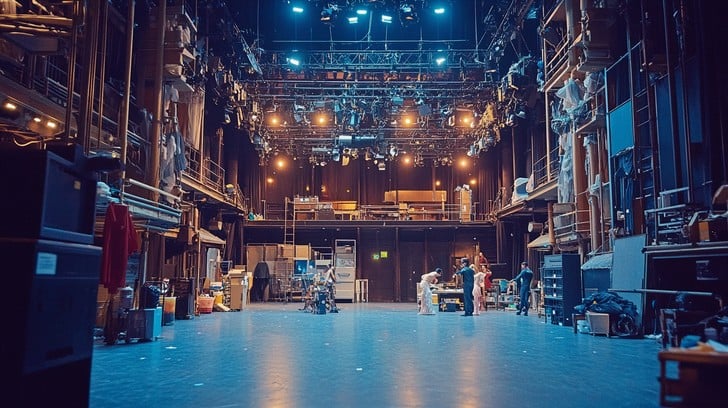Introduction
Stage lighting is one of the most powerful tools in the performing arts. Beyond simply illuminating actors and sets, lighting conveys mood, directs attention, and transforms storytelling. Among the countless aspects of lighting design, two key areas play a decisive role: the angle of illumination and the control of spotlight beams.This article explores professional techniques in lighting angle choices and spotlight control. It also discusses how directors, designers, and technicians can achieve nuanced, expressive results by carefully considering placement, intensity, and beam shaping. Whether in a campus theater, a professional drama house, or an outdoor performance, mastering these techniques ensures impactful stage experiences.

I. The Fundamentals of Lighting Angles
Lighting angles define how an object or actor is perceived. Different angles can emphasize or distort features, create dimension, and set emotional tones.
1. Front Lighting
Front lighting is the most basic form, ensuring visibility and clarity. A direct front wash highlights facial expressions but can appear flat if not combined with other angles.
2. Side Lighting
Side lighting emphasizes contours and movement. It is commonly used in dance and physical theater to showcase form and fluidity.
3. Top Lighting
Top-down lighting creates dramatic shadows, intensifying mood. It suggests isolation or focus while sculpting depth into stage pictures.
4. Back Lighting
Back lighting produces silhouettes and separation. It is essential for depth perception and can transform simple movements into iconic images.
5. Low-Angle Lighting
Lighting from below often evokes unnatural or eerie atmospheres. Used sparingly, it becomes effective in horror or surreal storytelling.
II. The Science of Angles and Emotion
Lighting designers often speak of the psychological effect of angles. For instance, a 45-degree angle is considered natural, balancing visibility with dimensionality. Side angles emphasize strength or mystery, while low angles evoke menace. Designers must carefully match angle choice with narrative intention.
III. Spotlight Control Techniques
Spotlights are the precision instruments of lighting design. Their control depends on three main factors:
Beam Size: Adjusting the lens and focus changes the size of the illuminated area, from sharp pinpoints to wide circles.
Edge Definition: Soft edges blend seamlessly into surrounding washes, while hard edges isolate subjects with intensity.
Movement and Tracking: Manual or automated spotlights follow performers, ensuring focus stays with the narrative center.
IV. Balancing Angles and Spotlights
True artistry arises from combining angle choices with spotlight control. A backlit performer, highlighted with a sharp spotlight from above, becomes both isolated and magnified. Conversely, blending a soft-edged front wash with subtle side spotlights creates warmth and intimacy.
V. Practical Applications Across Different Stages
Campus Performances
Amateur productions benefit from simple 45-degree front and side angles, ensuring clarity for parents and audiences while introducing subtle artistry.
Community Theaters
Small venues must maximize impact with limited fixtures. Strategic spotlight placement compensates for fewer wash lights, guiding audience focus economically.
Professional Theaters
Designers use multi-angle layering. Spotlights reinforce principal actors while washes and specials create immersive atmospheres.
Outdoor Events
Angles become broader due to distance, and spotlight control is vital to cut through ambient light and distractions.
VI. Common Mistakes in Angle and Spotlight Control
Overusing Front Light: Creates flat, uninteresting visuals.
Ignoring Shadows: Poor angle choices can distort features.
Harsh Spot Edges: Overly sharp focus can distract unless intentionally dramatic.
Inconsistent Tracking: Spotlights that fail to follow performers correctly break immersion.
VII. Artistic Inspirations
Some of the world’s most iconic productions succeed because of lighting mastery. Designers experiment with bold back angles, asymmetrical setups, and creative spotlight tricks to create unforgettable imagery. By studying these works, students and practitioners can expand their own vocabularies.
VIII. The Future of Angle and Beam Control
Technology continues to evolve. Intelligent fixtures allow real-time angle adjustments and programmable spot movement. Digital tools simulate light plots before rehearsals. These innovations enhance creative freedom but still rely on the designer’s understanding of classical principles.
Conclusion
Lighting is both science and art. The angle of illumination sculpts dimension, while spotlight control focuses narrative attention. Together, they form the foundation of stage storytelling. Mastery of these techniques empowers directors and designers to elevate performances, from small school productions to grand professional shows.
As Blue Sea Lighting continues to inspire the industry, the artistry of angles and spotlights remains central to stagecraft. By balancing precision and imagination, lighting designers create visual poetry that resonates long after the curtain falls.





Blue Sea Lighting is an enterprise with rich experience in the integration of industry and trade in stage lighting and stage special effects related equipment. Its products include moving head lights, par lights, wall washer lights, logo gobo projector lights, power distributor, stage effects such as electronic fireworks machines, snow machines, smoke bubble machines, and related accessories such as light clamps.
Quick Links
For more questions subscribe to our email








